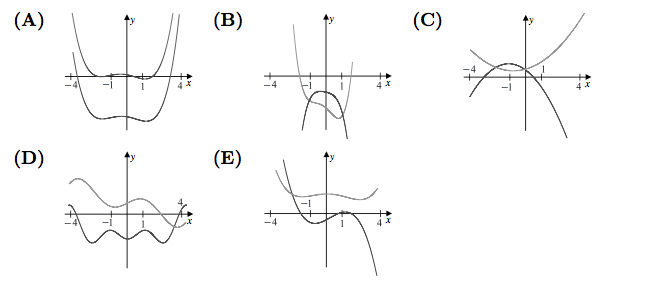Difference between revisions of "2002 AMC 12A Problems/Problem 25"
Jiangyunye (talk | contribs) (New page: The nonzero coefficients of a polynomial with real coefficients are all replaced by their mean to form a polynomial . Which of the following could be a graph of and over the interval ?) |
m (Minor edit in See Also) |
||
| (14 intermediate revisions by 11 users not shown) | |||
| Line 1: | Line 1: | ||
| − | The nonzero coefficients of a polynomial | + | ==Problem== |
| + | |||
| + | The nonzero coefficients of a polynomial <math>P</math> with real coefficients are all replaced by their mean to form a polynomial <math>Q</math>. Which of the following could be a graph of <math>y = P(x)</math> and <math>y = Q(x)</math> over the interval <math>-4\leq x \leq 4</math>? | ||
| + | |||
| + | [[File:2002AMC12A25.png]] | ||
| + | |||
| + | ==Solution 1== | ||
| + | |||
| + | The sum of the coefficients of <math>P</math> and of <math>Q</math> will be equal, so <math>P(1) = Q(1)</math>. The only answer choice with an intersection between the two graphs at <math>x = 1</math> is '''(B)'''. (The polynomials in the graph are <math>P(x) = 2x^4-3x^2-3x-4</math> and <math>Q(x) = -2x^4-2x^2-2x-2</math>.) | ||
| + | |||
| + | ==Solution 2== | ||
| + | |||
| + | We know every coefficient is equal, so we get <math>ax^n + ... + ax + a = 0</math> which equals <math>x^n + ... + x + 1 = 0</math>. We see apparently that x cannot be positive, for it would yield a number greater than zero for <math>Q(x)</math>. We look at the zeros of the answer choices. A, C, D, and E have a positive zero, which eliminates them. B is the answer. | ||
| + | |||
| + | ==See Also== | ||
| + | |||
| + | {{AMC12 box|year=2002|ab=A|num-b=24|after=Last Problem}} | ||
| + | {{MAA Notice}} | ||
Latest revision as of 01:25, 2 September 2024
Contents
[hide]Problem
The nonzero coefficients of a polynomial ![]() with real coefficients are all replaced by their mean to form a polynomial
with real coefficients are all replaced by their mean to form a polynomial ![]() . Which of the following could be a graph of
. Which of the following could be a graph of ![]() and
and ![]() over the interval
over the interval ![]() ?
?
Solution 1
The sum of the coefficients of ![]() and of
and of ![]() will be equal, so
will be equal, so ![]() . The only answer choice with an intersection between the two graphs at
. The only answer choice with an intersection between the two graphs at ![]() is (B). (The polynomials in the graph are
is (B). (The polynomials in the graph are ![]() and
and ![]() .)
.)
Solution 2
We know every coefficient is equal, so we get ![]() which equals
which equals ![]() . We see apparently that x cannot be positive, for it would yield a number greater than zero for
. We see apparently that x cannot be positive, for it would yield a number greater than zero for ![]() . We look at the zeros of the answer choices. A, C, D, and E have a positive zero, which eliminates them. B is the answer.
. We look at the zeros of the answer choices. A, C, D, and E have a positive zero, which eliminates them. B is the answer.
See Also
| 2002 AMC 12A (Problems • Answer Key • Resources) | |
| Preceded by Problem 24 |
Followed by Last Problem |
| 1 • 2 • 3 • 4 • 5 • 6 • 7 • 8 • 9 • 10 • 11 • 12 • 13 • 14 • 15 • 16 • 17 • 18 • 19 • 20 • 21 • 22 • 23 • 24 • 25 | |
| All AMC 12 Problems and Solutions | |
The problems on this page are copyrighted by the Mathematical Association of America's American Mathematics Competitions. 










